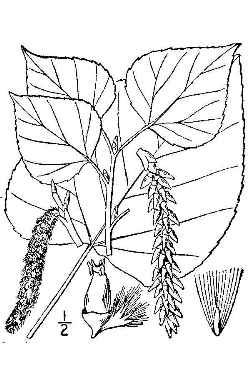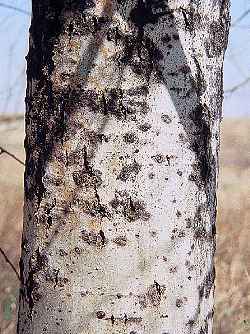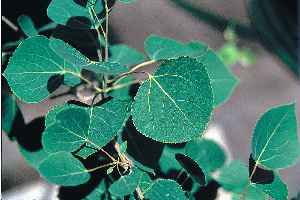Quaking Aspen
Scientific Name: Populus tremuloides Michx.
Synonym: Populus ×polygonifolia, Populus aurea, Populus cercidiphylla, Populus tremula ssp. tremuloides , Populus tremuloides var. aurea , Populus tremuloides var. cercidiphylla , Populus vancouveriana
Family: Salicaceae

Populus tremuloides, Britton, N.L., and A. Brown. 1913. Illustrated flora of the northern states and Canada. Vol. 1: 590. Courtesy of Kentucky Native Plant Society.
Sunset®: 1-7
USDA: 6-10
Heat Tolerance: Not heat resistant
Sun Exposure: Full sun
Origin: Most of North America
Growth Habits: Deciduous small to medium sized tree, 20 to 50 feet tall (6-15 m), 15 to 25 feet in spread (4.5 to 7.5), often occurring in thickets with all the trees suckers of the same root system; heart-shaped to roundish leaves, 1 to 3 inches long (2.5-7.5 cm), turning bright yellow in the fall
Watering Needs: Regular deep watering
Propagation: Cuttings, seeds, suckers
Propagation: Seed or occasionally cutting
- by semi-hardwood, hardwood secondary cuttings, in winter. Use outdoor beds.
- by seeds, in autumn. Germinates at 84-89 degrees F. The seeds can be harvested in summer. The usual germination temperature is 84-89 degrees F.

Populus tremuloides: trunk, Herman, D.E. et al. 1996. North Dakota tree handbook. USDA NRCS ND State Soil Conservation Committee

Populus tremuloides: leaves, Herman, D.E. et al. 1996. North Dakota tree handbook. USDA NRCS ND State Soil Conservation Committee
Blooming Habits:
Dioecious. The male and female trees bear hanging catkins, 1 to 3 inches long (2.5-7.5 cm)
Fruiting Habits:
The fruit, carried by the female trees is a woolly capsule enclosing six to eight small hairy seeds. A single female catkin generates many light green capsules.
Desert-Tropicals is dedicated to provide gardening advice, gardening ideas, and information about flower of all kind for landscape and collections.We try to check carefully the identification of the plants on the illustrations as well as the other information from the page, but occasionally errors do occur. if you notice anything that needs to be changed please contact us.Thanks.
© 1998-2020 Philippe Faucon, All Rights Reserved.